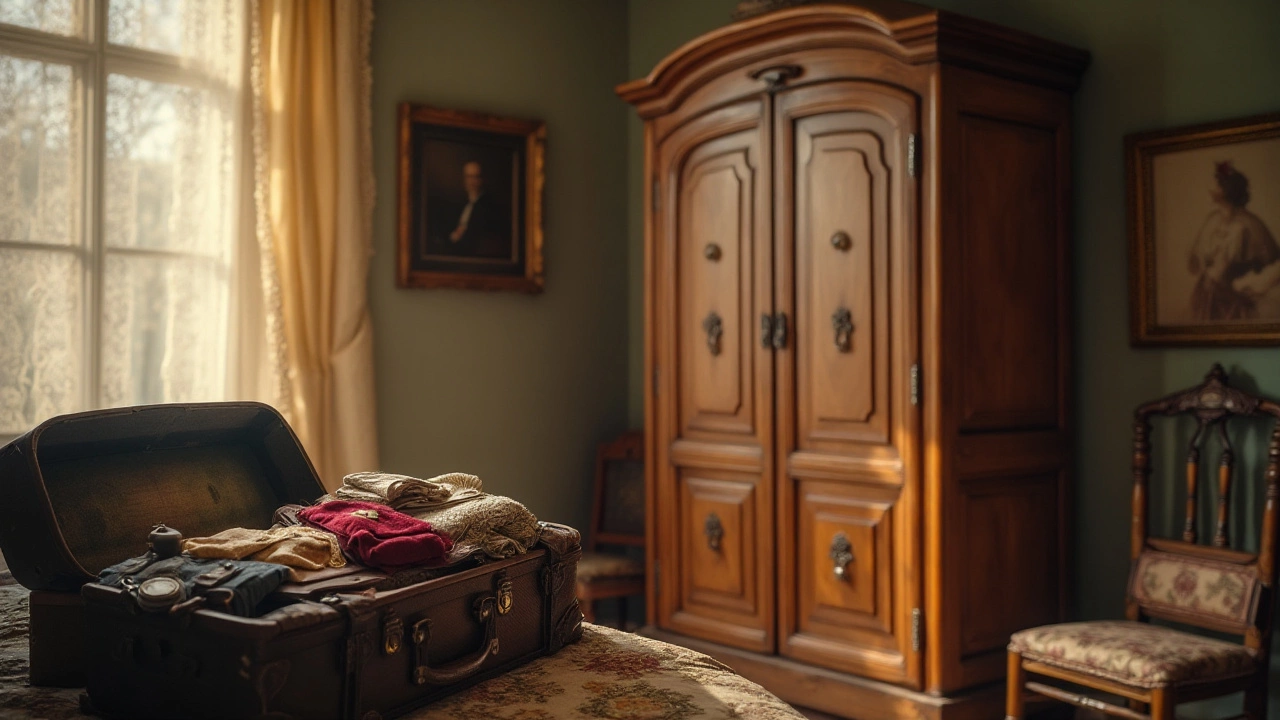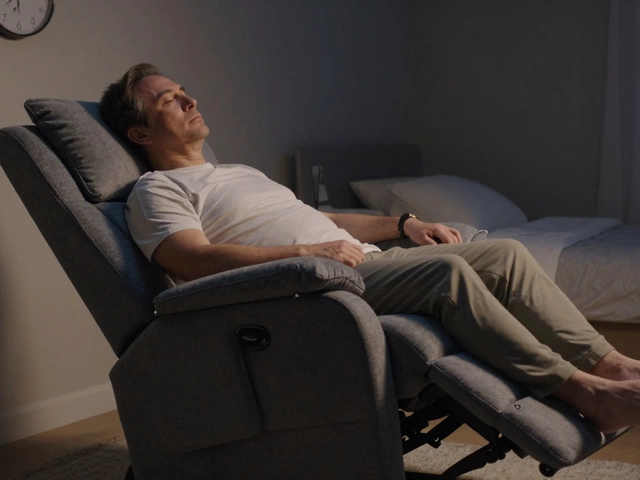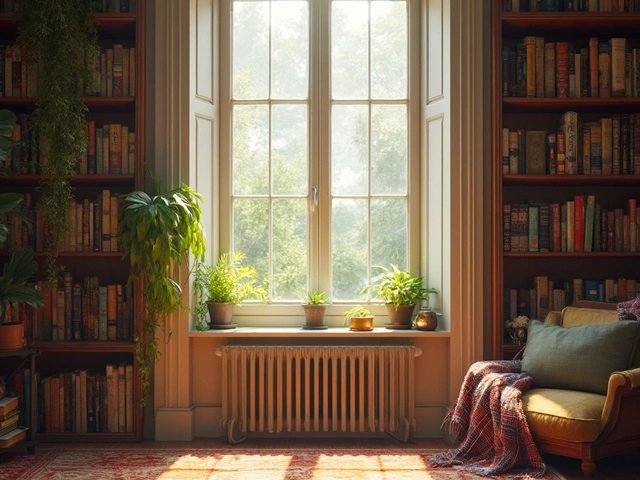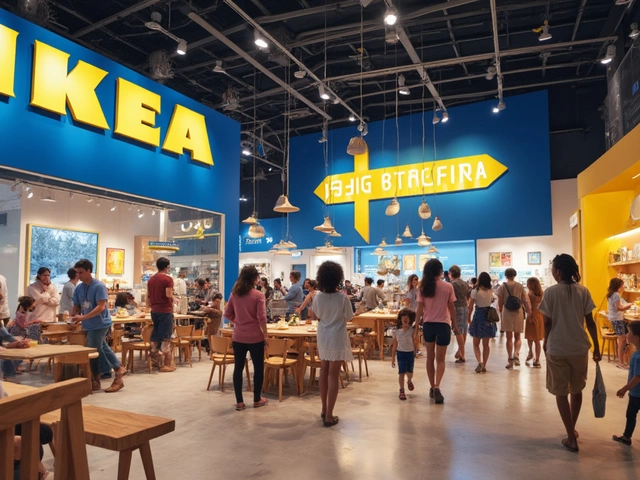What's in a name? When it comes to storage solutions in the home, quite a lot, actually. If you've ever pondered why people across the pond refer to wardrobes as 'closets,' you're not alone. The distinction isn't just in the name but also in the design and cultural significance.
In the realm of interior design, understanding these differences can help you make more informed choices when it comes to furnishing your home. Though both serve the same fundamental purpose of hanging clothes and storing belongings, the way wardrobes and closets are constructed and utilized varies between regions.
This article takes a closer look at how these pieces of furniture evolved differently across the world. By the end, you'll have a better grasp of which option might suit your living space and lifestyle best.
- Historical Origins of Wardrobes
- The American Closet Defined
- Types of Closets in the US
- Comparing Wardrobes and Closets
- Cultural Influences on Wardrobe Design
- Tips for Choosing the Right Storage Option
Historical Origins of Wardrobes
The history of the wardrobe is as rich and varied as the garments they house. The concept of a dedicated piece of furniture for clothing storage dates back centuries, evolving along with human society's understanding of privacy and personal space. In medieval Europe, clothing was both a necessity and a symbol of status, thus requiring proper storage. The first 'wardrobes' were little more than chests. Large, heavy wooden chests were not only utilized for storing garments but also for protecting them from the elements and pests. These chests, often ornately carved, reflected the wealth and standing of their owners.
As societies advanced and interior spaces became more defined, so did the need for specialized furniture. By the 14th century, the concept of a 'hanging closet' began to emerge, paving the way for the modern wardrobe. The term itself comes from Old French 'warderobe,' and to this day, the word evokes a certain European elegance. The design shifted from simple chests to upright cabinets with doors, shelves, and hangers. This transition marked the beginning of the wardrobe evolving into a staple piece of bedroom furniture, catering to an increasingly structured way of life where clothes and textiles were valued possessions.
The transformation of wardrobes over the years was not just architectural but also cultural. By the 18th century, wardrobes became larger and more complex, often mirror-clad to reflect both light and the wearer. The Victorian era saw wardrobes adorned with intricate designs and craftsmanship, heavily influenced by the industrial revolution, which allowed for mass production. Notable furniture makers of the time began innovating storage solutions within wardrobes, integrating drawers and compartments to house burgeoning wardrobes of a more fashion-conscious public. Reflecting on these developments, one can trace a clear narrative of societal progress and the increasing importance of personal belongings in our homes.
In the words of renowned historian Joanne Smith:
"The evolution of the wardrobe from a simple chest to an elaborate piece of furniture is a testament to humanity's growing desire for organization and aesthetics."As the 20th century dawned, wardrobes divided into two streams: the freestanding furniture cherished by European traditions and the built-in closets predominantly in American homes. This era also saw the advent of different materials and styles, catering to a range of personal tastes and homes. The wardrobe no longer just met a practical need but also became an expression of personal style, playing a significant role in interior design.
Today, the wardrobe remains an essential feature in billions of homes worldwide. While the term may primarily resonate with populations in Europe and certain other parts of the world, its concept continues to bridge cultures, influencing global designs, and home aesthetics. Understanding its historical journey helps appreciate this seemingly humble piece of furniture as a witness to changing lifestyles, fashion trends, and the continuous human quest for beauty and order in domestic spaces.
The American Closet Defined
The term closet in America has evolved into much more than just a space for hanging clothes. In the grand annals of home design, the closet is a staple in American households, fundamentally defined as a small enclosed area—a little room, if you will—that is dedicated to storing clothing and personal items. Traditionally, closets are built-in features of the bedroom or hallway with varying sizes depending on the era of the house. These designs range from small utility spaces to expansive walk-in configurations that cater to the modern penchant for maximalist storage and organizational possibilities.
One notable aspect of American closets is how they reflect an evolution spurred by both necessity and an ever-growing consumer culture. Unlike the freestanding furnishings of wardrobes seen historically, the integrated nature of closets in American homes speaks volumes about architectural trends through the decades. The closet was popularized in the early 20th century, aligning with a shift toward more fluid and spacious residential layouts. The onset of these integrated storage solutions often accompanied advancements in the construction of suburban homes post-World War II, booming into a cultural mainstay.
Interestingly, the American closet also embodies a societal trend towards personalization and customizable spaces. Today, closets can feature an array of organizational installments, like shelving units and drawer systems designed to optimize storage efficiency. Some homeowners even transform these spaces into mini-boutiques with lighting, mirrors, and even seating to provide a personalized haven for dressing. According to a survey conducted by the National Association of Home Builders in 2022, about 60% of home buyers consider walk-in closets a key factor in their purchasing decision, highlighting the feature's desirable nature.
For an example of the impact a closet has, consider the words of renowned interior designer Nate Berkus, who once noted,
"Your closet is who you are when you think no one's watching. It's a place to unapologetically keep all the things that represent your personal style."This view underscores the closet's role beyond mere functionality, emphasizing a space that reflects individual identity and lifestyle choices.
Stepping inside a typical American closet, one might find intelligent designs that include, but are not limited to, bars for hanging clothes, compartments for shoes, bins, and seasonal storage cubes. In modern homes, homeowners often integrate environmental consciousness by utilizing sustainable materials and building a streamlined space that serves various purposes yet remains easy to access and maintain. Beyond the practicalities, these spaces sometimes serve dual functions, such as craft corners or even cozy reading nooks, highlighting the versatility embedded within the concept of the American closet.
In summary, while a wardrobe might evoke images of ornate, standalone furniture pieces in other parts of the world, in the U.S., the more streamlined, integrated closet reflects a distinctly American approach to storage. It subtly captures the ideals of efficiency, convenience, and personal expression, making it an indelible aspect of home life. From modest reach-in designs to luxurious walk-ins, the adaptability and prevalence of the American closet speak to its enduring significance in the landscape of interior architecture and personal organization.
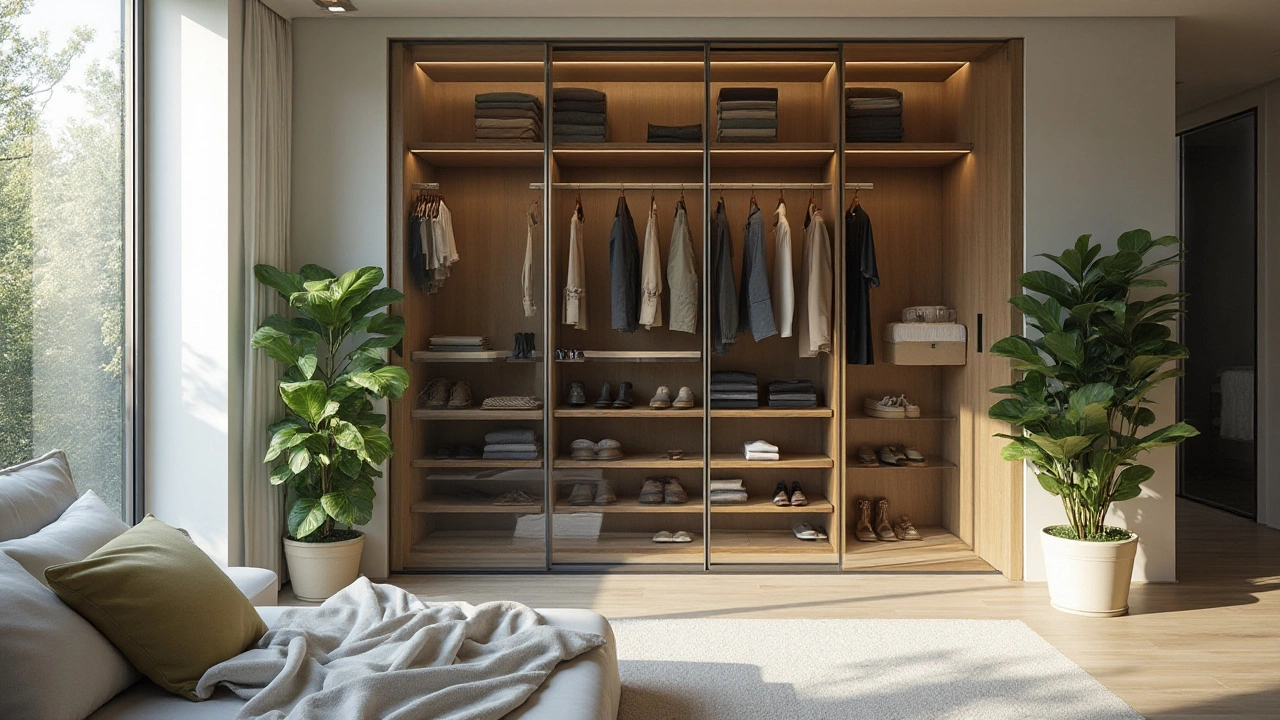
Types of Closets in the US
Americans have been creative when it comes to naming and designing their spaces for clothing storage. While all closets serve the essential purpose of storing garments and personal items, they come in various forms, adding functionality and style to homes. One of the most common types is the walk-in closet. These spacious enclosures are often large enough to double as personal dressing rooms, complete with a mix of hanging rods, shelves, and drawers. They typically require more space, and therefore, are usually found in larger homes. A walk-in closet is an excellent choice for fashion enthusiasts who love keeping their clothing and accessories highly organized and easily accessible.
Another popular option is the reach-in closet. As the name suggests, these closets are smaller, designed for efficiency rather than spaciousness. Often fitted with sliding or bi-fold doors to save space, reach-in closets are common in bedrooms and hallways where space is more limited. Despite their smaller size, a cleverly designed reach-in can be quite effective, providing ample room with a strategic combination of rods, shelves, and even shoe racks for storage.
The broom closet might not be your conventional wardrobe space, but it plays a crucial role in maintaining household order. Typically found in kitchens or hallways, this type of closet is meant for storing cleaning supplies, but with adequate shelving, it can be a lifesaver for stashing various odds and ends that don’t belong elsewhere.
Linen closets are another variety, primarily used for storing towels, bed linens, and other textiles. These are commonly located near bathrooms or bedrooms, offering easy access to essential items. Their shelving is usually adjustable, making it simple to organize items as needs change over time.
Some older homes feature the cedar closet, which is a unique variant lined with cedar wood. This type of closet offers a natural repellant to moths and other insects, making it perfect for storing seasonal clothes that might otherwise attract pests.
“The closet is not just a storage space, it’s an area where organization meets personal tastes, allowing homeowners to express themselves within the confines of necessity.” – Home Design Magazine
The diversity of American closet designs reflects the spirit of innovation and the importance of adaptability in home living. Whether choosing a design for a sprawling suburban home or a compact city apartment, understanding these closet options can be quite beneficial. Alongside functionality, aesthetics and personal preferences play crucial roles in selecting the ideal closet type, ensuring it not only serves its purpose but complements the overall living space.
Comparing Wardrobes and Closets
When you dive into the world of home storage, the ideas of a wardrobe and a closet often get tangled up like a pair of old shoelaces. Each serves as a sanctuary for your beloved outfits, shoes, and sundry accessories. Yet, there's a world of difference hidden behind those closed doors. At its core, a wardrobe is a standalone piece of furniture, a timeless icon that traces its roots back to medieval Europe. Crafted from rich woods, adorned with intricate designs, these pieces stand as both functional and aesthetic centerpieces in bedrooms, almost like a stubborn witness to fashion's numerous evolutions. In contrast, closets are built-in spaces, conceived as part of the room's very architecture. Dominantly featured in American homes, closets offer a subtler presence, often tucked inside walls and emphasizing practicality over flamboyance.
Let's talk about the evolution. Historically, wardrobes were crucial due to architecture's limitations. Houses didn't feature inbuilt storage space until well into the 20th century, when closets became increasingly vital in the US. The change was fueled largely by urbanization—people moving into smaller spaces needed efficient storage. Allowing everything from blazers to beachwear to vanish from sight, closets offer a level of space economy you'd be hard-pressed to find elsewhere. Yet, what they've gained in practicality, they've arguably lost in artistic charm—lacking the standalone craftsmanship and versatility often displayed by wardrobes.
Battling for Space
Space utilization makes closets and wardrobes shine in their unique ways. A tidy closet requires that harmonious marriage between organized shelving and smart spatial design. The challenge comes not just in storing clothes but in accessing them easily. That's where wardrobes win people over. Offering shelves, hanging space, and often drawers, they give wardrobe owners better division and access without the rigidity of fixed wall units. A well-designed wardrobe breathes more life into a room, adaptable to both hardwood floors and thick-pile carpets. Consumer surveys reflect this emotional connection; homeowners often express more appreciation for wardrobes due to their nostalgia and artistic expression. Nearly 40% of Brits said they preferred wardrobes because of their character and the way they can transform a room's aesthetic.
"While closets serve as functional necessities in an American household, wardrobes bring a touch of the personal into modern living spaces, acting much like a storyteller of one's personal style," says interior designer Marjorie Flack.
For those environmental enthusiasts, wardrobes offer an edge due to their portability and potential for upcycling. In contrast, removing or altering a closet requires labor-intensive renovation—often equating to significant waste. In today’s sustainable-driven society, wardrobes represent an eco-friendly choice that aligns with minimalist movements. On the flip side, walk-in closets—or the epitome of modern American luxury—offer a dream playground for fashionistas, combining modern design with the charm of a personal wardrobe gallery.
So whether you’re a lover of classic furniture or a fan of streamlined, built-in solutions, your choice can speak volumes about not just your clothes, but your personality and lifestyle preferences. If you're ever battling between these two options, it's not merely a choice of space; it's an embrace of culture, convenience, and creativity.
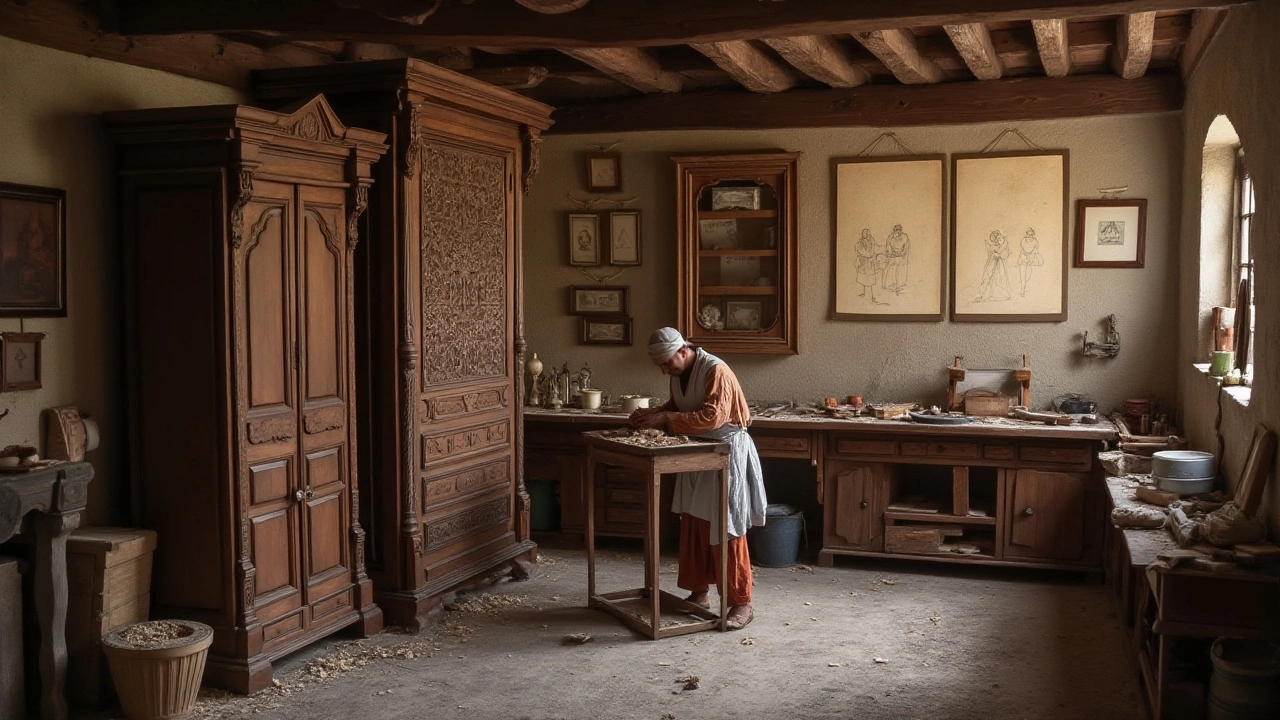
Cultural Influences on Wardrobe Design
The evolution of wardrobe design has been deeply entwined with cultural shifts and societal necessities. Across the centuries, how we store our clothes and belongings has mirrored changes in lifestyle, fashion, and even technology. Wardrobes, initially large, stand-alone pieces of furniture, were crafted with exacting attention to detail, often doubling as both a storage solution and a statement of wealth and style. This was especially true during the Victorian era in Europe, where intricately carved wood with gilded trims signified a household's affluence.
Across the Atlantic in America, the transition from such grand pieces to the more built-in structures like the closet can be linked to the development of homes themselves. As American cities expanded quickly, the urban shift necessitated the need for more compact living spaces. Built-in closets, therefore, were a space-saving innovation that began to replace the cumbersome wardrobes. Known for their practicality, closets fit neatly into the architecture of smaller homes, leading to a preference that grew over time.
"Design has always been a reflection of the way we live. Our homes, therefore, must cater to practicality and comfort," says renowned interior designer Nate Berkus.
In contemporary times, the shape and functionality of storage solutions continue to evolve. Today, global influences are more prominent, with Scandinavian minimalism gaining popularity worldwide. This design philosophy emphasizes clean lines, functional spaces, and a strong connection to nature, all of which can be easily observed in modern furniture design. Japanese culture, too, has left its mark, particularly with its principle of 'less is more,' where efficient space usage takes precedence. Walk-in closets, now a staple in many American homes, borrow heavily from this minimalist approach, with sections dedicated to shoes, clothing, and accessories all within the same room-sized space.
Moreover, modern wardrobes and closets are often designed to incorporate new technologies. From motion-sensor lighting to smart storage solutions that allow for better organization, advancements are continuously reshaping our traditional understanding of these household elements. The environmental impact also plays a crucial role, with more sustainable materials being sourced to create eco-friendly furniture.
Modern Considerations and Sustainability
Wardrobes and closets today do not just reflect personal style but also ethical choices, contributing to a broader culture of conscious consumerism.Another cultural influence is the way fashion itself dictates storage needs. As fashion trends evolve, so do the requirements for space and accessibility. The rise of fast fashion may require frequent changes in storage dynamics, whereas a move towards more timeless fashion trends correlates with techniques that preserve clothing for longer durations. In this dynamic landscape, wardrobes and closets have become personalized spaces that speak volumes about the owner's tastes and values.
- Scandinavian minimalism's impact on design.
- The role of technology in modern wardrobes.
- Sustainable furniture production trends.
Tips for Choosing the Right Storage Option
When it comes to selecting the perfect storage solution for your home, the decision often lies between the classic wardrobe and the versatile closet. The choice depends largely on your living situation, personal taste, and organizational needs. Consider the available space in your home, as this will significantly dictate the type of storage unit you can accommodate. Closets, often built into the architecture of a room, maximize space and can be customized with shelves and compartments. On the other hand, wardrobes can stand freely and add a certain charm and character to a room, especially in homes where historical aesthetics are cherished.
It's essential to think about what exactly you need to store. If you're dealing with a high volume of clothing, especially items that require hanging, a closet might offer more comprehensive solutions, as modern designs often incorporate rods, shelves, and even shoe racks. In contrast, wardrobes might be more suitable for storing a mix of folded and hanging garments, and they can often include additional features like mirrored doors or lockable compartments for added security. These features can offer both practical benefits and enhance the visual appeal of your space.
Don't underestimate the power of organization tools and add-ons in both closets and wardrobes. Consider incorporating hanging organizers or drawer dividers – these can dramatically increase your storage capacity while keeping your belongings accessible. Another important factor is to think about lighting: both closets and wardrobes benefit greatly from good lighting, which ensures every item is visible and easy to find. Some wardrobes come with built-in LED lights; however, you can also retrofit a closet with motion-sensor lights for convenience.
A wardrobe allows a room to maintain its architectural integrity without permanent installation, providing flexibility if you frequently rearrange your living space. Closets, in contrast, may increase the resale value of your property due to their built-in nature and widespread appeal in many modern homes. Both options can be aesthetically customized to match or elevate the current decor of your home, so it's useful to consider material and design compatibility as well.
A famous designer, Nate Berkus, once said, "Your home should tell the story of who you are, and be a collection of what you love." Choosing between a wardrobe and a closet isn't just about practicality; it's about what resonates with your persona and fits into your home's narrative.At the end of the day, your storage choice should reflect not just utility but also a bit of you. Dive into what’s trending in home interiors, experiment with mixes of materials and finishes, and don’t be afraid to personalize with vibrant color schemes or classic neutral tones.
